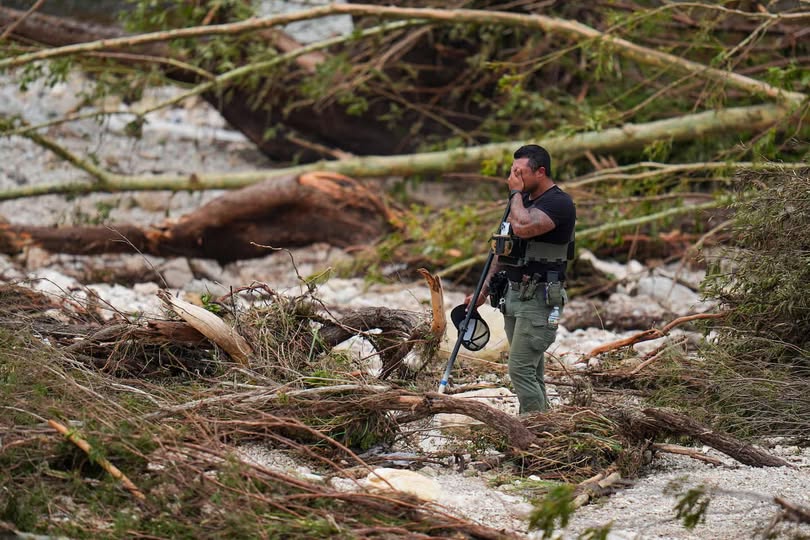As search and rescue efforts intensify across flood-ravaged Central Texas, the human toll of the disaster is becoming painfully clear—not only in lives lost or missing, but in the heavy burden carried by the very people trying to save them.
Officials have confirmed more than 200 rescues since the unprecedented flash flooding began early on the Fourth of July, triggered by torrential rainfall that caused rivers like the Guadalupe and San Gabriel to rise by more than 20 feet in less than an hour. Most of these rescues occurred in the Texas Hill Country, where the terrain made evacuations treacherous and time short.
Among the heroes is one rescue swimmer credited with saving 165 individuals, many of them campers and staff at Camp Mystic, where dozens were swept away when the Guadalupe River broke its banks in the early hours of Friday morning.
But for those on the front lines, every successful rescue comes with the knowledge that not everyone could be saved.
The Silent Weight Carried by First Responders
One Kerr County deputy, after hours of pulling victims from trees and flooded cabins, broke down in tears when asked about the young girls still missing from Camp Mystic.
“We heard them screaming,” he said, his voice cracking. “We just couldn’t get to all of them in time.”
That deputy, who spoke on condition of anonymity, described working alongside National Guard crews and Texas DPS helicopter units, lowering ropes and baskets into a swirl of debris, muddy current, and uprooted trees.
“You train for this. You plan for this. But nothing prepares you for when you have to leave someone behind.”
A Statewide Effort, and Still Not Enough
Governor Greg Abbott has declared a state of disaster in 14 counties, and 400+ emergency personnel have been deployed to the flood zones. Eighteen helicopters, dozens of boats, and multiple swift-water rescue teams continue to comb the waterways and surrounding floodplains.
But despite the unprecedented response, the death toll in Kerr County alone has risen to 43, with at least 27 girls still missing from Camp Mystic.
Camp staff have described scenes of chaos and heroism—counselors tying themselves to trees to prevent being swept away while trying to hold onto younger campers; others using overturned furniture as makeshift rafts. But in some cabins, the river moved too fast.
One Rescue Swimmer’s Relentless Mission
The rescue swimmer who reportedly saved 165 victims has not been named, but officials from the Texas Task Force 1 urban search and rescue team confirmed the number.
“He went cabin to cabin, tree to tree,” one commander said. “He refused to stop until he physically could not continue.”
At one point, the swimmer reportedly collapsed after carrying multiple girls through neck-deep water while tethered to a line.
“He was dehydrated, bruised, and still asking to go back in,” the commander added. “He saved so many. But he still thinks about the ones he didn’t reach.”
The Toll Beyond the Waters
Mental health experts say it is critical that first responders be given emotional and psychological support—not just after such disasters, but throughout their deployment.
“These men and women are witnessing tragedy in real time,” said Dr. Aimee Larson, a trauma psychologist working with Texas first responders. “And too often, they carry the grief silently.”
Peer counseling teams and chaplains have been dispatched to staging areas, especially in Kerrville and Georgetown, where rescue crews have worked around the clock for three days. Volunteers have also begun preparing hot meals and writing personal thank-you cards to rescuers.
As the Waters Recede, the Emotional Flood Remains
In a poignant moment captured by a local reporter, the unnamed Kerr County deputy stood waist-deep in floodwater, clutching a soaked stuffed animal found downstream from Camp Mystic.
“It probably belonged to one of the girls,” he said softly, holding back tears. “We’ll try to get it to the family.”
The weight of every life lost, every child still missing, and every parent still waiting is being carried not just by families—but by the first responders who stood between survival and tragedy.
Support for Rescuers and Victims Alike
As rescues continue and recoveries begin, local organizations are asking the public not only to pray for those affected, but to support first responders. Donations, letters of gratitude, and counseling resources are being coordinated by the Texas Association of First Responders.
Meanwhile, for those still hoping for good news about their loved ones, every rescuer returning from the flood zone brings both hope—and the weight of what could not be saved.
If you or a first responder you know is struggling with trauma or emotional fatigue, help is available:
-
First Responders Crisis Line: 1-866-676-7500
-
Suicide & Crisis Lifeline: 988 (call or text)
-
Texas Disaster Mental Health Hotline: 1-800-985-5990
The battle against the water may be nearing its end. But for Texas’s brave rescuers, the healing is just beginning.

